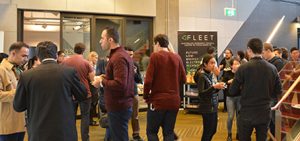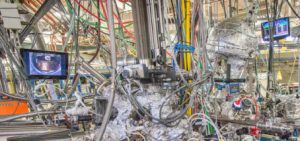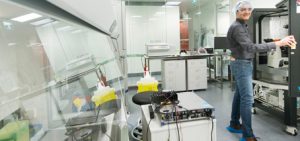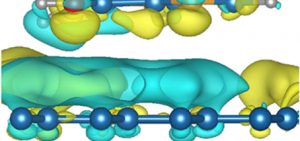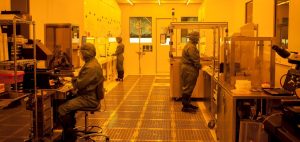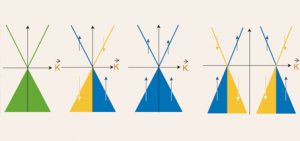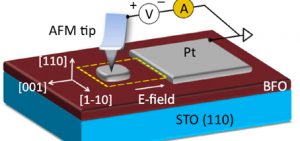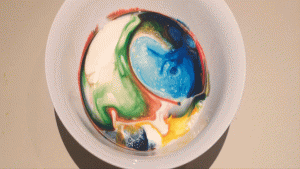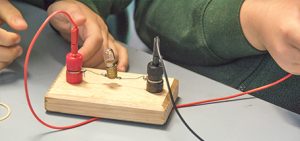FLEET News
Where can your PhD take you? And how can you maximise your potential future? A group of STEM PhDs and higher degree researchers heard about career options post-PhD at a forum last month, run by FLEET at Monash University. The assembled panel of academics, entrepreneurs, business development and research managers shared their own diverse career journeys and top tips on …
FLEET’s mission to create ultra-low energy electronics depends on an improved fundamental understanding of the electronic structure of atomically-thin, two-dimensional materials. We need to understand how electrons in the material interact with each other and also how they move and scatter through the crystal lattice. FLEET researchers using the vacuum ultraviolet the UV beamline 10.0.1 (HERS) at the Advanced Light …
Kourosh Kalantar-zadeh’s ingestible smart pill could revolutionise prevention and diagnosis of gut disorders/disease, and make a significant difference to the health of as many as one in five Australians who suffer gut disorders. This month the technology won the prestigious 2017 IEEE Sensors Council achievement award in the field of sensors. Read more at RMIT. At RMIT,Prof Kalantar-zadeh is Director …
FLEET Director Michael Fuhrer spoke today with science show Einstein a gogo on 3RRR about energy use in information and communications technology (ICT), limits to our ability to squeeze more efficiency out of traditional silicon-based technologies, and the alternatives that FLEET is pursuing, including topological materials and atomically-thin materials. Listen
From Monash University Insider (staff only) While a smartphone or home PC itself doesn’t burn too much energy, a tremendous amount of electricity is consumed in the massive data centres (or ‘server farms’) that keep us all connected via the net. A new, ARC-funded research centre aims to address the growing computing energy challenge using materials that are just one …
There is considerable excitement about graphene-based biosensors. In particular, the material’s unique structure and electronic properties offers great potential for rapid, reliable DNA/RNA sensing and sequencing. To date, this potential has been checked by a lack of fundamental understanding of graphene−nucleobase interactions and the origin of measured molecular fingerprints. A recent study has defined key interactions as DNA/RNA nucleobases are …
Monash University’s recent open day provided a great opportunity to explain FLEET to a large audience. The FLEET zone in the School of Physics and Astronomy area allowed for hands-on demonstrations, while lab tours provided a closer look at the research and FLEET director Michael Fuhrer presented a talk on the big picture challenges of energy use in global computing. …
FLEET features in this month’s annual ‘nano’ edition of the Australian Manufacturing Tech magazine. The article looks at growth of atomically thin and other novel materials and nanofabrication, with a particular focus on partnerships. Atomically thin material projects presented include semiconductor fabrication at RMIT University (Lan Wang) and the University of Wollongong (Xiaoliang Wang) and molecular beam epitaxy (Mark Edmonds …
FLEET research has been highlighted at an important conference in Würzburg, Germany. Eli Estrecho, a PhD student in Elena Ostrovskaya’s group at ANU, won the 1st “Gold” award (and €500) for the best poster presentation entitled ‘Single-shot imaging of exciton-polariton condensates’ and David Colas, a Postdoctoral Fellow in Matt Davis’ group won one of the 3rd “Bronze” prizes for his poster …
A University of Wollongong study has tightened the search for materials that would allow for ultra-fast, ultra-low energy ‘spintronic‘ electronics with no wasted dissipation of energy from electrical conduction. Spintronics is an emerging field of electronic study in which the ‘spin’ of electrons (their intrinsic angular momentum) is used in addition to their charge. Conventional electronics and information technology are …
A UNSW study published last Friday presents an exciting step towards a novel form of electronics based on nano-scale, ‘disappearing’ conduction paths that could allow for extremely dense memory storage. It’s based on domain walls, which are atomically sharp topological defects separating regions of uniform polarisation in ferroelectric materials. The domain walls are electrically conductive, while the surrounding of the wall …
FLEET aims to make science more accessible to the wider community, and to bring science to kids who will become Australia’s future great scientists and engineers. So today, we’re launching a new program of home science activities for kids. FLEET will provide ideas for fun science activities and experiments that are easy to do in the home. Our first three …
A recent Monash University study has investigated Fermi gases with only a small number of interacting particles, and has used that simplified case to predict some behaviours within Fermi gases with many more particles. The study was published in Journal of Physics B: Atomic, Molecular and Optical Physics, March 2017 FLEET’s Meera Parish is investigating how robust excitonic superfluidity is …
FLEET’s Senior Education & Training Coordinator visited a primary school to speak to Grade 2 students about electricity and electrons. Students were challenged to make a light bulb light up using a battery and some wires, and to find materials that could act as conductors. The students have been studying about materials and technology this term, so the topics fit …
FLEET is seeking 16 talented postdoctoral scientists with backgrounds in Physics, Materials Science, Chemistry, Nanotechnology, Electronic Engineering and other equivalent fields. Research fellowships are available for talented postdoctoral scientists, offered at six FLEET nodes: Monash University, the University of New South Wales, RMIT University, Swinburne University of Technology, the Australian National University and the University of Wollongong. Work with us …

